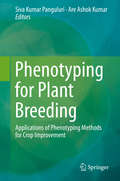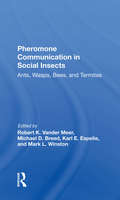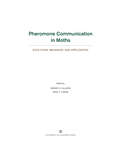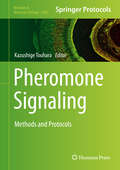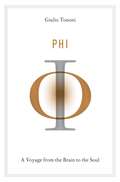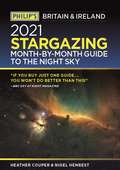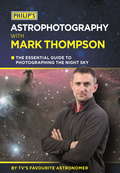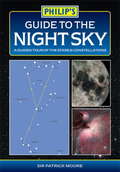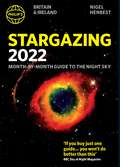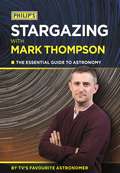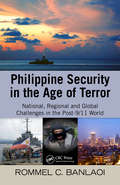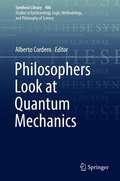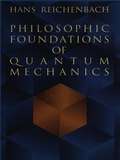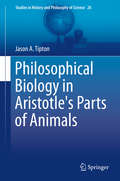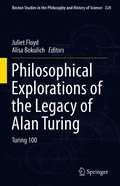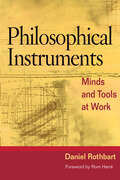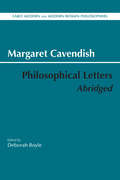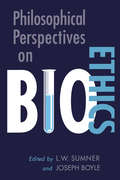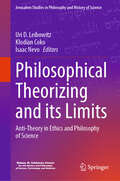- Table View
- List View
Phenotyping for Plant Breeding
by Siva Kumar Panguluri Are Ashok KumarPlant phenotyping is the thorough assessment of plant traits such as growth, development, adaptation, yield, quality, tolerance, resistance, architecture, and the basic measurement of individual quantitative parameters that form the basis for understanding of traits. Genetic approaches to understand plant growth and development have always benefitted from phenotyping techniques that are simple, rapid and measurable in units. The forward genetics approach is all about understanding the trait inheritance using the phenotypic data and in most cases it is the mutant phenotypes that formed the basis for understanding of gene functions. With rapid advancement of genotyping techniques, high throughput genotyping has become a reality at costs people never imagined to be that low, but the phenotypic methods did not receive same attention. However, without quality phenotyping data the genotyping data cannot be effectively put to use in plant improvement. Therefore efforts are underway to develop high-throughput phenotyping methods in plants to keep pace with revolutionary advancement in genotyping techniques to enhance the efficiency of crop improvement programs. Keeping this in mind, we described in this book the best phenomic tools available for trait improvement in some of the world's most important crop plants.
Pheromone Communication In Social Insects: Ants, Wasps, Bees, And Termites (Westview Studies In Insect Biology)
by Mark Winston Robert K Vander Meer Michael D Breed Karl E EspelieBringing together for the first time prominent researchers in social insect pheromone communication, including nestmate recognition, this book looks at ants, wasps, bees, and termites, highlighting areas of convergence and divergence among these groups, and identifying areas that need further investigation. Presenting broad synthetic overviews as
Pheromone Communication in Moths: Evolution, Behavior, and Application
by Jeremy D. Allison Ring T. CardéCommon among moths is a mate-finding system in which females emit a pheromone that induces males to fly upwind along the pheromone plume. Since the chemical pheromone of the domesticated silk moth was identified in 1959, a steady increase in the number of moth species whose pheromone attractants have been identified now results in a rich base for review and synthesis. Pheromone Communication in Moths summarizes moth pheromone biology, covering the chemical structures used by the various lineages, signal production and perception, the genetic control of moth pheromone traits, interactions of pheromones with host-plant volatiles, pheromone dispersal and orientation, male pheromones and courtship, and the evolutionary forces that have likely shaped pheromone signals and their role in sexual selection. Also included are chapters on practical applications in the control and monitoring of pest species as well as case studies that address pheromone systems in a number of species and groups of closely allied species. Pheromone Communication in Moths is an invaluable resource for entomologists, chemical ecologists, pest-management scientists, and professionals who study pheromone communication and pest management.
Pheromone Signaling: Methods and Protocols
by Kazushige TouharaProviding experimental methods and protocols for performing pheromone research in a variety of organisms ranging from invertebrates to vertebrates, Pheromone Signaling: Methods and Protocols covers a wide spectrum of experimental approaches necessary for handling pheromone molecules, measuring receptor response and neural activation, and analyzing behavioral output. A great deal of progress has been made in understanding the molecular mechanisms underlying pheromone action, largely due to the discovery of receptor genes, the advancement of imaging techniques, and key multi-disciplinary approaches including aspects of organic chemistry, biochemistry, molecular biology, electrophysiology, and behavioral science. Written in the highly successful Methods in Molecular Biology series format, chapters include introductions to their respective topics, lists of the necessary materials and reagents, step-by-step, readily reproducible laboratory protocols, and tips for troubleshooting and avoiding known pitfalls. Authoritative and practical, Pheromone Signaling: Methods and Protocols details the key methodologies utilized in laboratories all over the world, making them accessible to those who want to begin investigation in the area of pheromone research.
Pheromones and Animal Behavior
by Tristram D. WyattWe are entering one of the most exciting periods in the study of chemical communication since the first pheromones were identified some 40 years ago. This rapid progress is reflected in this book, the first to cover the whole animal kingdom at this level for 25 years. The importance of chemical communication is illustrated with examples from a diverse range of animals including humans, marine copepods, Drosophila, Caenorhabditis elegans, moths, snakes, goldfish, elephants and mice. It is designed to be advanced and up-to-date, but at the same time accessible to readers whatever their scientific background. For students of ecology, evolution and behaviour, this book gives an introduction to the rapid progress in our understanding of olfaction at the molecular and neurological level. In addition, it offers chemists, molecular and neurobiologists an insight into the ecological, evolutionary and behavioural context of olfactory communication.
Phi: A Voyage from the Brain to the Soul
by Giulio TononiThis title is printed in full color throughout.From one of the most original and influential neuroscientists at work today, here is an exploration of consciousness unlike any other--as told by Galileo, who opened the way for the objectivity of science and is now intent on making subjective experience a part of science as well. Galileo's journey has three parts, each with a different guide. In the first, accompanied by a scientist who resembles Francis Crick, he learns why certain parts of the brain are important and not others, and why consciousness fades with sleep. In the second part, when his companion seems to be named Alturi (Galileo is hard of hearing; his companion's name is actually Alan Turing), he sees how the facts assembled in the first part can be unified and understood through a scientific theory--a theory that links consciousness to the notion of integrated information (also known as phi). In the third part, accompanied by a bearded man who can only be Charles Darwin, he meditates on how consciousness is an evolving, developing, ever-deepening awareness of ourselves in history and culture--that it is everything we have and everything we are. Not since Gödel, Escher, Bach has there been a book that interweaves science, art, and the imagination with such originality. This beautiful and arresting narrative will transform the way we think of ourselves and the world.
Philip's 2021 Stargazing Month-by-Month Guide to the Night Sky in Britain & Ireland
by Nigel Henbest Heather Couper"If you buy just one guide... you won't do better than this" BBC Sky at Night Magazine"You're very much in the dark without this illuminating superstar of a guide." Popular Astronomy"I will continue to enjoy 'Philip's Stargazing' as the months go by" Helen Sharman, Astronaut "Very useful indeed" Chris Lintott, Sky at Night presenterDiscover the latest in star gazing with the new and definitive guide to the night sky.Whether you're a seasoned astronomer or just starting out, Philip's Stargazing 2021 is the only book you'll need. Compiled by experts and specially designed for use in Britain and Ireland, Stargazing 2021 acts as a handily illustrated and comprehensive companion.- 12 Brand-New Maps for year-round astronomical discovery- Month-to-Month informationDaily Moon Phase Calendar, highlighting special lunar events throughout the year- Planet Watch for ideal viewing days in 2021- Avoid light pollution with our detailed Dark Sky Map- Expert advice and insight throughout from internationally renowned Professors Couper and Henbest- Using Binoculars - Stargazing recommendations from expert Robin Scagell- Perfect for home use during lockdown- Complete calendar of major astronomical events, including the Top 20 Sky Sights of 2021- Jargon Buster, explaining common or confusing terms - The planets' movements explained from solar and lunar eclipses to meteor showers and comets
Philip's 2021 Stargazing Month-by-Month Guide to the Night Sky in Britain & Ireland (Philip's Stargazing)
by Nigel Henbest"If you buy just one guide... you won't do better than this" BBC Sky at Night Magazine"You're very much in the dark without this illuminating superstar of a guide." Popular Astronomy"I will continue to enjoy 'Philip's Stargazing' as the months go by" Helen Sharman, Astronaut "Very useful indeed" Chris Lintott, Sky at Night presenterDiscover the latest in star gazing with the new and definitive guide to the night sky.Whether you're a seasoned astronomer or just starting out, Philip's Stargazing 2021 is the only book you'll need. Compiled by experts and specially designed for use in Britain and Ireland, Stargazing 2021 acts as a handily illustrated and comprehensive companion.- 12 Brand-New Maps for year-round astronomical discovery- Month-to-Month informationDaily Moon Phase Calendar, highlighting special lunar events throughout the year- Planet Watch for ideal viewing days in 2021- Avoid light pollution with our detailed Dark Sky Map- Expert advice and insight throughout from internationally renowned Professors Couper and Henbest- Using Binoculars - Stargazing recommendations from expert Robin Scagell- Perfect for home use during lockdown- Complete calendar of major astronomical events, including the Top 20 Sky Sights of 2021- Jargon Buster, explaining common or confusing terms - The planets' movements explained from solar and lunar eclipses to meteor showers and comets
Philip's Astrophotography With Mark Thompson: The Essential Guide To Photographing The Night Sky By TV's Favourite Astronomer
by Mark ThompsonPhilip's Astrophotography With Mark Thompson is an essential guide for anyone wishing to photograph or image the stars and planets, written by TV's favourite astronomer.For many people, looking at the sky is not enough and they would love to try and capture what they can see. Until a few years ago, capturing astronomical images was fraught with many challenges, but with the development of digital cameras replacing film, things have become much easier and great astronomical images are now within the reach of even the most novice stargazer.Mark Thompson has spent many years capturing the beauty of the night sky, first with film and now with the digital camera, and has discovered and overcome many of the pitfalls. This book takes the reader on a journey through the world of capturing astronomical images from using the humble mobile phone to specialist cameras, brought to life with Mark's personal experiences and many of his own astronomical images.
Philip's Guide to the Night Sky: A guided tour of the stars and constellations (Philip's Guide to...)
by Sir Patrick MooreFind your way around the night sky with this handy guide to stargazing for the complete novice. In Philip's Guide to the Night Sky, Sir Patrick Moore explains how to find the most famous constellations and the brightest stars, and when to look for them. Clear star maps, showing stars visible to the naked eye, help you to navigate the skies. The maps are suitable for use in Britain, Ireland, northern Europe and Canada.Sir Patrick introduces the wonders of the night sky to absolute beginners in his characteristically entertaining and informative style. The Moon, the planets, the Sun and the stars are explained in non-technical language, while the constellations are described with the help of star maps and tables.The four main chapters in Philip's Guide to the Night Sky are devoted to what's on view in each season of the year. The information is appropriate for observers in Britain and Ireland, northern Europe and Canada; it will also be helpful a little outside these latitudes. Using prominent patterns, such as the Plough and Orion, Sir Patrick teaches the reader to 'star-hop' from constellation to constellation, thus learning to navigate the night sky. Star maps and photographs illustrate and clarify what will be on view. Philip's Guide to the Night Sky is an ideal introduction to stargazing, suitable for all ages and with no need for anything more technical than the naked eye.
Philip's Stargazing 2022 Month-by-Month Guide to the Night Sky in Britain & Ireland (Philip's Stargazing)
by Nigel Henbest<p>"If you buy just one guide...you won't do better than this" - BBC Sky at Night Magazine<p> <p>"I will continue to enjoy 'Philip's Stargazing' as the months go by" - Helen Sharman, Astronaut<p> <p>"Very useful indeed" - Chris Lintott, Sky at Night presenter<p> <p>Discover the latest in stargazing with the new and definitive guide to the night sky. Whether you're a seasoned astronomer or just starting out, Philip's Stargazing 2022 is the only book you'll need. Compiled by experts and specially designed for use in Britain and Ireland, Stargazing 2022 acts as a handily illustrated and comprehensive companion.<p> <p>- 12 Brand-New Maps for year-round astronomical discovery- Month-to-Month information. Daily Moon Phase Calendar, highlighting special lunar events throughout the year- Planet Watch for ideal viewing days in 2022- Avoid light pollution with our detailed Dark Sky Map- Expert advice and insight throughout from internationally renowned Professor Nigel Henbest- A 'Behind the Scenes' look at astrophotography from expert Robin Scagell- Complete calendar of major astronomical events, including the Top 20 Sky Sights of 2022- Jargon Buster, explaining common or confusing terms - The planets' movements explained from solar and lunar eclipses to meteor showers and comets.<p>
Philip's Stargazing 2023 Month-by-Month Guide to the Night Sky Britain & Ireland (Philip's Stargazing)
by Nigel Henbest"If you buy just one guide...you won't do better than this" BBC Sky at Night Magazine"I will continue to enjoy 'Philip's Stargazing' as the months go by" Helen Sharman, Astronaut"Very useful indeed" Chris Lintott, Sky at Night presenterNow including the top astronomical places to visit, star festivals and the latest on star parties in Britain and Ireland, the new 2023 edition is totally up-to-date for exploring the wonder of the night skies, month-by-month and day-by-day. Whether you're a seasoned astronomer or just starting out, Philip's Stargazing 2023 is the only book you'll need. Compiled by experts and specially designed for easy and daily use, Stargazing 2023 acts as a handily illustrated and comprehensive companion.- 12 updated sky charts for year-round astronomical discovery- Month-to-Month information. Daily Moon Phase Calendar, highlighting special lunar events throughout the year- Planet Watch for ideal viewing days in 2023- The best places to experience Dark Skies, along with the latest on Star Festivals and Star Parties- Top places to visit for astronomical insights- Expert advice and insight throughout from internationally renowned Prof Nigel Henbest- The latest on electronic telescopes from expert Robin Scagell- Complete calendar of major astronomical events, including the Top 20 Sky Sights of 2023- Jargon Buster, explaining common or confusing terms - The planets' movements explained from solar and lunar eclipses to meteor showers and comets
Philip's Stargazing With Mark Thompson: The Essential Guide To Astronomy By TV's Favourite Astronomer
by Mark ThompsonPhilip's Stargazing With Mark Thompson provides the perfect introduction to the fascinating hobby of astronomy for beginners, written by TV's favourite astronomer.With 30 years' experience in observational astronomy and helping hundreds of newcomers get started in their new hobby, Mark Thompson takes everything he has learned and leads his readers skilfully through their early stargazing experiences in this brand-new book - Philip's Stargazing With Mark Thompson. He provides a wealth of knowledge, with valuable hints and tips to aid beginners in their first steps in astronomy. Not only does Mark demonstrate great observational techniques and how to find the brighter objects in the sky, but he guides his readers through the important steps of choosing and using a telescope.This is a book that will not only act as a guide to the novice astronomer but, by drawing on Mark's own experiences, will be a companion to share in the wonders of the night sky.
Philip's Stargazing With Mark Thompson: The Essential Guide To Astronomy By TV's Favourite Astronomer
by Mark ThompsonPhilip's Stargazing With Mark Thompson provides the perfect introduction to the fascinating hobby of astronomy for beginners, written by TV's favourite astronomer. With 30 years' experience in observational astronomy and helping hundreds of newcomers get started in their new hobby, Mark Thompson takes everything he has learned and leads his readers skilfully through their early stargazing experiences in this brand-new book - Philip's Stargazing With Mark Thompson. He provides a wealth of knowledge, with valuable hints and tips to aid beginners in their first steps in astronomy. Not only does Mark demonstrate great observational techniques and how to find the brighter objects in the sky, but he guides his readers through the important steps of choosing and using a telescope. This is a book that will not only act as a guide to the novice astronomer but, by drawing on Mark's own experiences, will be a companion to share in the wonders of the night sky.
Philippine Security in the Age of Terror: National, Regional, and Global Challenges in the Post-9/11 World
by Rommel BanlaoiAs the twelfth most populous nation, the Philippines diverse religious and ethnic population makes it an ideal example of the changing tenet of what is deemed national security post 9/11. Issues previously considered social or public are now viewed as security issues. Food production is now analyzed in the context of food security and environmenta
Philosophers Look at Quantum Mechanics (Synthese Library #406)
by Alberto CorderoThis edited volume explores the philosophical implications of quantum mechanics. It features papers from venues of the International Ontology Congress (IOC) up to 2016. IOC is a worldwide platform for dialogue and reflection on the interactions between science and philosophy.The collection features philosophers as well as physicists, including David Albert, Harvey Brown, Jeffrey Bub, Otávio Bueno, James Cushing, Steven French, Victor Gomez-Pin, Carl Hoefer, Simon Kochen, Peter Lewis, Tim Maudlin, Peter Mittlestatedt, Roland Omnès, Juha Saatsi, Albert Solé, David Wallace, and Anton Zeilinger.Since the early days of quantum mechanics, philosophers have studied the subject with growing technical skill and fruitfulness. Their efforts have unveiled intellectual bridges between physics and philosophy. These connections have helped fuel the contemporary debate about the scope and limits of realism and understanding in the interpretation of physical theories and scientific theories in general. The philosophical analysis of quantum mechanics is now one of the most sophisticated and productive areas in contemporary philosophy, as the papers in this collection illustrate.
Philosophic Foundations of Quantum Mechanics
by Hans ReichenbachPhysics concerns direct analysis of the physical world, while philosophy analyzes knowledge about the physical world. This volume combines both disciplines for a philosophical interpretation of quantum physics -- an interpretation free from the imprecision of metaphysics, offering a view of the atomic world and its quantum mechanical results as concrete as the visible everyday world.Written by an internationally renowned philosopher who specialized in symbolic logic and the theory of relativity, this approach consists of three parts. The first section, which requires no background in math or physics, reviews the basics of quantum mechanics, outlining their philosophical interpretation and summarizing their results. The second part, which presupposes a knowledge of calculus, outlines the mathematical methods of quantum mechanics; and the third part blends the philosophical ideas of the first part and the mathematical formulations of the second part to develop a variety of interpretations of quantum mechanics. The author presents in-depth discussions of each interpretation, constructing a conclusion in terms of three-valued logic that offers readers a satisfactory logical form of quantum mechanics.Focusing on clarification of concepts rather than developing problem-solving skills, this volume will prove enlightening to students of mathematics, physics, and the other sciences.
Philosophical Biology in Aristotle's Parts of Animals
by Jason A. TiptonThis book provides a detailed analysis of Aristotle's Parts of Animals. It presents the wealth of information provided in the biological works of Aristotle and revisits the detailed natural history observations that inform, and in many ways penetrate, the philosophical argument. It raises the question of how easy it is to clearly distinguish between what some might describe as "merely" biological and the philosophical. It explores the notion and consequences of describing the activity in which Aristotle is engaged as philosophical biology. The book examines such questions as: do readers of Aristotle have in mind organisms like Ascidians or Holothurians when trying to understand Aristotle's argument regarding plant-like animals? Do they need the phenomena in front of them to understand the terms of the philosophical argument in a richer way? The discussion of plant-like animals is important in Aristotle because of the question about the continuum between plant and animal life. Where does Aristotle draw the line? Plant-like animals bring this question into focus and demonstrate the indeterminacy of any potential solution to the division. This analysis of Parts of Animals shows that the study of the nature of the organic world was Aristotle's way into such ontological problems as the relationship between matter and form, or form and function, or the heterogeneity of the many different kinds of being.
Philosophical Engineering: Toward a Philosophy of the Web (Metaphilosophy)
by Harry Halpin Alexandre MonninThis is the first interdisciplinary exploration of the philosophical foundations of the Web, a new area of inquiry that has important implications across a range of domains. Contains twelve essays that bridge the fields of philosophy, cognitive science, and phenomenology Tackles questions such as the impact of Google on intelligence and epistemology, the philosophical status of digital objects, ethics on the Web, semantic and ontological changes caused by the Web, and the potential of the Web to serve as a genuine cognitive extension Brings together insightful new scholarship from well-known analytic and continental philosophers, such as Andy Clark and Bernard Stiegler, as well as rising scholars in “digital native” philosophy and engineering Includes an interview with Tim Berners-Lee, the inventor of the Web
Philosophical Explorations of the Legacy of Alan Turing: Turing 100 (Boston Studies in the Philosophy and History of Science #324)
by Alisa Bokulich Juliet FloydThis volume presents an historical and philosophical revisiting of the foundational character of Turing's conceptual contributions and assesses the impact of the work of Alan Turing on the history and philosophy of science. Written by experts from a variety of disciplines, the book draws out the continuing significance of Turing's work. The centennial of Turing's birth in 2012 led to the highly celebrated "Alan Turing Year", which stimulated a world-wide cooperative, interdisciplinary revisiting of his life and work. Turing is widely regarded as one of the most important scientists of the twentieth century: He is the father of artificial intelligence, resolver of Hilbert's famous Entscheidungsproblem, and a code breaker who helped solve the Enigma code. His work revolutionized the very architecture of science by way of the results he obtained in logic, probability and recursion theory, morphogenesis, the foundations of cognitive psychology, mathematics, and cryptography. Many of Turing's breakthroughs were stimulated by his deep reflections on fundamental philosophical issues. Hence it is fitting that there be a volume dedicated to the philosophical impact of his work. One important strand of Turing's work is his analysis of the concept of computability, which has unquestionably come to play a central conceptual role in nearly every branch of knowledge and engineering.
Philosophical Instruments: Minds and Tools at Work
by Daniel RothbartThe surprising roles of instruments and experimentation in acquiring knowledge In Philosophical Instruments Daniel Rothbart argues that our tools are not just neutral intermediaries between humans and the natural world, but are devices that demand new ideas about reality. Just as a hunter's new spear can change their knowledge of the environment, so can the development of modern scientific equipment alter our view of the world. Working at the intersections of science, technology, and philosophy, Rothbart examines the revolution in knowledge brought on by recent advances in scientific instruments. Full of examples from historical and contemporary science, including electron scanning microscopes, sixteenth-century philosophical instruments, and diffraction devices used by biochemical researchers, Rothbart explores the ways in which instrumentation advances a philosophical stance about an instrument's power, an experimenter's skills, and a specimen's properties. Through a close reading of engineering of instruments, he introduces a philosophy from (rather than of) design, contending that philosophical ideas are channeled from design plans to models and from model into the use of the devices.
Philosophical Letters, Abridged (Early Modern and Modern Women Philosophers)
by Margaret Cavendish"Margaret Cavendish (1623–1673) is a fascinating figure who is getting increasing attention by historians of philosophy these days, and for good reason. . . . She&’s an interesting advocate of a vitalist tradition emphasizing the inherent activity of matter, as well as its inherent perceptive faculties. She&’s also the perfect character to open students (and their teachers) up to a different seventeenth century, and a different cast of philosophical characters. This is an ideal book to use in the classroom. The Philosophical Letters (1664) gives us Cavendish&’s view of what was interesting and important in the philosophical world at that moment, a view of philosophy as it was at the time by an engaged participant. There are few documents like it in the history of philosophy. Deborah Boyle&’s Introduction provides a very accessible summary of Cavendish&’s natural philosophy, as well as good introductions to the other figures that Cavendish discusses in the book. Boyle&’s annotations are not extensive, but they are a great help in guiding the student toward an informed reading of the texts." —Daniel Garber, Princeton University
Philosophical Perspectives in Quantum Chemistry (Synthese Library #461)
by Olimpia Lombardi Sebastian Fortin Juan Camilo Martínez GonzálezThis book explores the philosophy and the foundations of quantum chemistry. It features chapters written by experts in the field. The contributions analyze quantum chemistry as a discipline, in particular, its relation with both chemistry and physics from the viewpoint of realism and reduction. Coverage includes such topics as quantum chemistry as an “in-between” discipline, molecular structure and quantum mechanics, quantum chemical models, and atoms and molecules in quantum chemistry.The interest of this book is twofold. First, the contributions aim to update and refresh the discussions regarding the foundations of quantum chemistry. Second, they seek to develop new philosophical perspectives that this discipline can suggest to philosophers of science.From its origins, quantum chemistry filled a problematic position in the disciplinary space. On the one hand, it is a branch of theoretical chemistry. On the other hand, it appeals essentially to theoretical tools coming from physics. This peculiar position triggered conceptual questions about its own identity. Inside this book, readers will find updated discussions on the foundations and the philosophy of this complex discipline.
Philosophical Perspectives on Bioethics
by L. Wayne Sumner Joseph BoyleHow should we attempt to resolve concrete bioethical problems? How are we to understand the role of bioethics in the health care system, government, and academe? This collection of original essays raises these and other questions about the nature of bioethics as a discipline. The contributors to the volume discuss various approaches to bioethical thinking and the political and institutional contexts of bioethics, addressing underlying concerns about the purposes of its practice. Included are extended analyses of such important issues as the conduct of clinical trials, euthanasia, justice in health care, the care of children, cosmetic surgery, and reproductive technologies.
Philosophical Theorizing and its Limits: Anti-Theory in Ethics and Philosophy of Science (Jerusalem Studies in Philosophy and History of Science)
by Uri D. Leibowitz Klodian Coko Isaac NevoThis book brings together scholars from ethics and philosophy of science in order to identify ways in which insights gleaned from one subfield can shed light on the other. The book focuses on two radical Anti-Theory movements that emerged in the 1970’s and 1980’s, one in philosophy of science and the other in ethics. Both movements challenged attempts to supply general, systematized philosophical theories within their domains and thus invited the reconsideration of what philosophical theorizing can and should offer. Each of these movements was domain-specific – that is, each criticized the aspirations to philosophical theories within its own domain and advanced arguments aimed at philosophers within their own specific subfield. The innovative systematic comparative examination of these movements by scholars from each domain sheds new light on some familiar debates, offers new and exciting paths of research to pursue in each domain, provides insight into the place of science and ethics in contemporary life and culture, and enables a fresh view on the longstanding and alluring philosophical aspiration for a fully general, absolute theory of reality and an ultimate objective foundational theory of knowledge.
